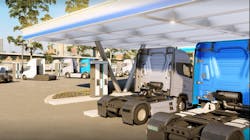Voltera execs talk fleet charging infrastructure challenges, opportunities
It’s been about two months since Voltera, which develops and operates electric vehicle charging facilities as a turnkey service for fleets, went public. Now, the EV charging startup has added four new executives to help the company overcome some of the roadblocks many fleets face as they prepare to deploy commercial EVs at scale.
Voltera’s CEO Matt Horton brought in talent from EV charging competitor TeraWatt Infrastructure and those who previously worked for EV manufacturer Rivian. Kit Ahuja, Voltera’s new VP of energy services and operations, has a decade of experience scaling up operations at companies like Tesla, Enel X, Rivian, and TeraWatt. Jonathan Colbert has been hired as VP of marketing to support the development of Voltera’s go-to-market strategy and most recently served as the VP of business development at TeraWatt, worked for Rivian prior to that, and was also responsible for implementing charging programs for Mercedes-Benz dealerships, Daimler facilities, and drivers. Josh Kelaher, Voltera’s director of technical operations, was most recently the director of field service at TeraWatt and before that responsible for field service operations for energy and charging at Rivian. Justin Sztyk, Voltera’s director of construction, previously worked on Rivian’s L2 charging network and most recently served as director of construction at TeraWatt.FleetOwner recently sat down with Horton, Ahuja, and Colbert to discuss the latest developments in the commercial electric vehicle charging space and Voltera’s plans for growth as a fleet charging-as-a-service provider.
(Editor’s note: The following conversation has been edited for brevity and clarity.)
FO: What are some of the latest EV charging trends you’re seeing, and how are you planning to leverage your expertise as a team to help fleets navigate new alternative power options?
Jonathan Colbert: I was recently at a Harbor Trucking Association meeting of truckers that serve the ports on the West Coast. There was a presentation from a fuel cell truck provider and the questions ranged from: ‘Where do we even find information about these vehicles to leasing to grants to pricing on the vehicles and to how do we even charge these vehicles or fuel them?
There’s a natural progression these operators are going through. A lot of it starts with education and resources and understanding what it means, but it always comes back to ‘How will I charge the vehicle, and how will I fuel it on the fuel cell side? A lot of what we’re going to be doing in the short term is educating in the space and trying to set level-set expectations of what this entails.
Some of the issues fleets will be facing very quickly when they are thinking about charging is: ‘How do I bring the appropriate amount of power to the site? What charger should I be using? What is the warranty period of this charger? What can I expect from an operations standpoint?’
Quite frankly, these are not only new, but you could argue that these are problems they shouldn’t have to solve.
FO: How are you figuring out what charging solutions work best for specific operations?
Matt Horton: We have to recognize that every customer has slightly different needs. It’s about working with the customers upfront to find the right location and develop the right solution that works for them. Having said that, there are a bunch of things that are consistent from one deployment to the next. No. 1: power is hard to come by.
In the industry, we have already harvested a lot of the low-hanging fruit in terms of charging locations, and we need to do the hard work as an industry to go out and develop new sources of power, work with utilities, and bring power to where it’s going to be needed in the future. Every site has its unique characteristics in terms of permitting and designs.
Customers are in a hurry and under pressure to deploy charging infrastructure. Today, the power is not typically found where they need it, and in many cases, we are working to find the right properties and get the power developed well in advance of when the customer is going to need it.
Kit Ahaju: It takes a lot of listening to what our customers are looking for. Ultimately, what matters most to them is the reliability of all those operations.
FO: What are some of the challenges when it comes to working with utilities, and how might some of that work vary state to state and project to project?
JC: Our solutions architect specifically is working through what is the appropriate source of generation on site that may be able to bridge the gap between the power we will get from the utility and what the customer needs sooner than that—that is everything from battery storage to using natural gas or turning natural gas into hydrogen. Some nuances [include projects] that aren’t yet approved by CARB or the utilities that we are working with in California. Having to take all that into account and pick a solution that is not only good for that site, but if it’s mobile is ideal for multiple sites, is pretty tricky. These are all problems that we are looking to solve right now.
MH: There are a few remaining pockets of power availability, but as an industry we have to almost rewire the utility network to be ready for electrification. In most cases, that is not universally happening, and the utilities are waiting for parties like Voltera to show up and request power at specific sites and work with them. We’re doing a lot of analytical work to understand where the power is going to be and then take on that role ourselves to make sure that we are bringing power to those charging deserts where there isn’t enough power available today.
The scope of the opportunity is enormous. The estimates in the U.S. and Europe are that we will need to spend $360 billion in capital to meet the needs just by 2030, and over $1 trillion in capital by 2040.
FO: What are some projections you have for EV charging as we head into 2023?
MH: It’s a combination of capital; investments from federal, state, and local governments; and interest from customers. My forecast is we are going to build out the infrastructure in this country incredibly quicky, and it’s going to surprise a lot of people just how fast this gets going.
JC: We’ll start to see this mad dash to take advantage of the funding and the public chargers that are available for fleets and [passenger] drivers and consumers. Fleets need to know that when their vehicle pulls into a site that it’s able to charge and there is no disruption of business.
The hope is we are going to meet the demand of the vehicle supply that is starting to ramp up right now. Two and three years from now is when you’ll start to see fleet charging centers.
KA: One trend on the negative front that we are already seeing is the lack of reliability in the space. Right now, we are falling well below the uptime percentages for businesses looking to operate with the surety of when their vehicles will be up and running and hitting the road. We have a responsibility to start expanding out the infrastructure and the solutions necessary to meet that same operational reliability that fleets are looking for.
We need to keep an open mind about the companies that we need to partner with to be successful; this is not a one company thing. We are going to hone in on what our supply chain needs to look like. What does labor look like? What do our software and hardware solutions look like to provide that reliability to our customers?
FO: Related to uptime and trying to avoid disruption of service, what are some other areas of concern?
JC: Something we are thinking about that I don’t think most fleets are thinking about or even most charging providers are really servicing well is vehicle interoperability. From a software and hardware integration standpoint, we want to make sure that when our customers’ fleets pull into our site that everything works without a hitch.
KA: We learned through our pain points that interoperability is something that needs to be improved. We are working through that to ensure that our technology works for fleets before they even purchase vehicles from OEMs.
Supply chains are still constrained and stressed, and it’s really difficult to provide the infrastructure necessary. The utility aside, getting the equipment is another challenge. We are setting up strategic relationships on the hardware front to make sure that we’ll have what we need to deploy in the first place and for managing the spare parts inventory process.
FO: What happens when the grid is out? How do you work to keep freight hauling operations running?
KA: Grid resiliency is really important. For the sites that we identify as risk sites, where maybe there could be impacts due to weather or a site in California where BEVs may have to cut back because of rolling blackouts, how do we look at grid resiliency on the site itself by providing battery storage? Those are the things we are actively looking at and building within our supply chain and the energy procurement process that we use.
About the Author

Cristina Commendatore
Cristina Commendatore is a past FleetOwner editor-in-chief. She wrote for the publication from 2015 to 2023.

